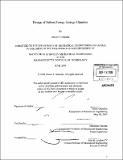Design of subsea energy storage chamber
Author(s)
Greenlee, Alison S
DownloadFull printable version (5.662Mb)
Other Contributors
Massachusetts Institute of Technology. Dept. of Mechanical Engineering.
Advisor
Alexander Slocum.
Terms of use
Metadata
Show full item recordAbstract
Energy generated from offshore resources is not reliable over short periods of time. Although wind and wave energy is fairly consistent in the long run, their short term capacity fluctuations prohibit these resources from replacing dependable fossil-fuel based energy systems. This limitation could be overcome if the energy harvested from these resources could be stored temporarily and then released when needed. The large hydrostatic head at the ocean floor provides a unique opportunity for storing energy offshore. Similar to hydroelectric dams storing water at a high potential, energy could be stored offshore by displacing water from a subsea chamber. This chamber could be incorporated into the mooring system of present offshore harvesting devices to yield more favorable economics. This report establishes the baseline assumptions for designing this energy storage device and proposes a methodology for constructing a beta level prototype. In addition to discerning the tradeoffs between different design options with respect to the marine environment, this study analyzes the cost of this structure per unit energy stored. The contents of this report comprise of the following. First, the hazards inherent to the marine environment are explored qualitatively, and methods to address these issues are proposed. Second, the chamber shape, mooring type, and amount of material are determined based on their respective costs. Finally, this report concludes with the final dimensions of a proposed beta prototype and a list of recommendations for future work.
Description
Thesis (S.B.)--Massachusetts Institute of Technology, Dept. of Mechanical Engineering, 2009. Cataloged from PDF version of thesis. Includes bibliographical references (p. 25).
Date issued
2009Department
Massachusetts Institute of Technology. Department of Mechanical EngineeringPublisher
Massachusetts Institute of Technology
Keywords
Mechanical Engineering.